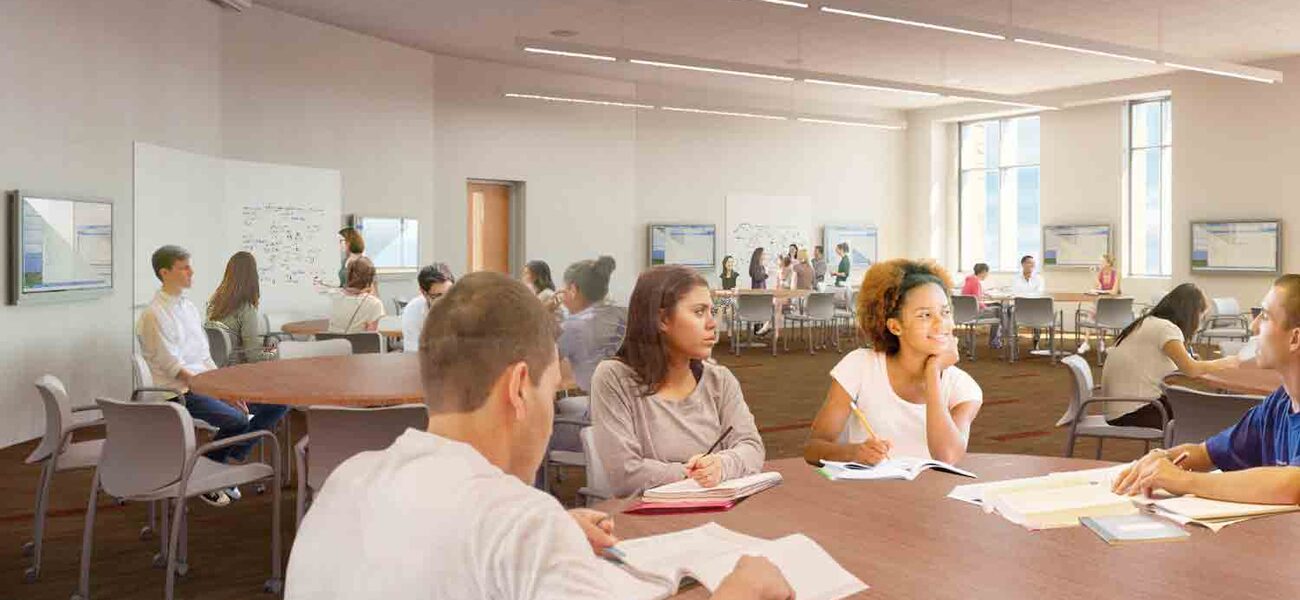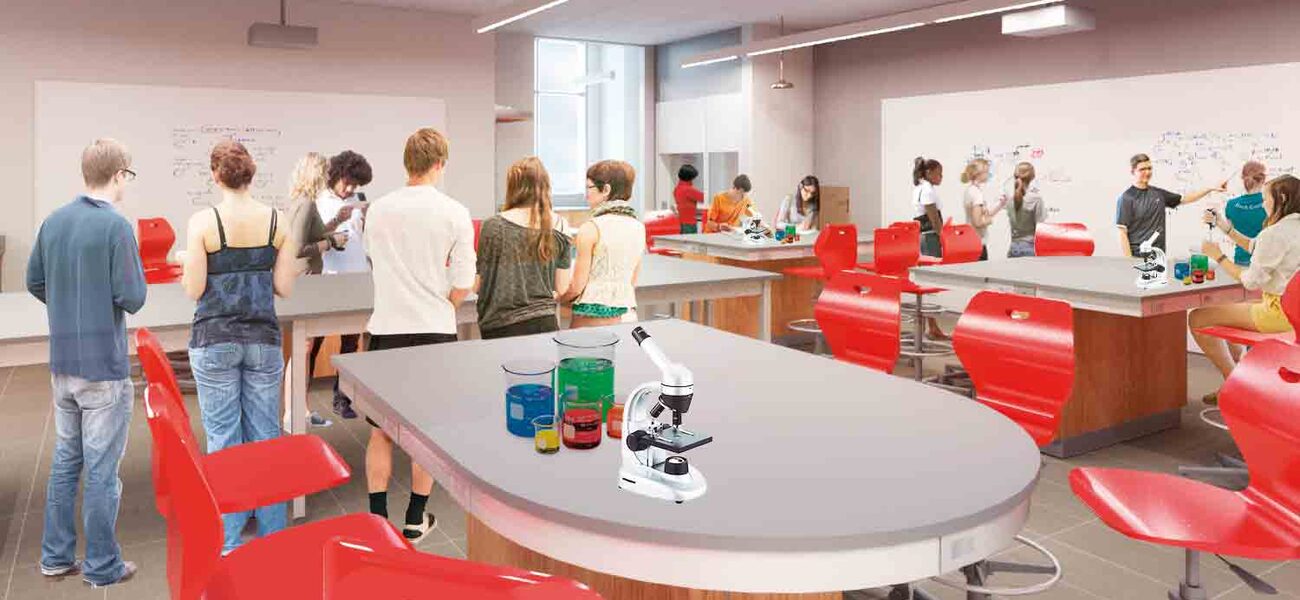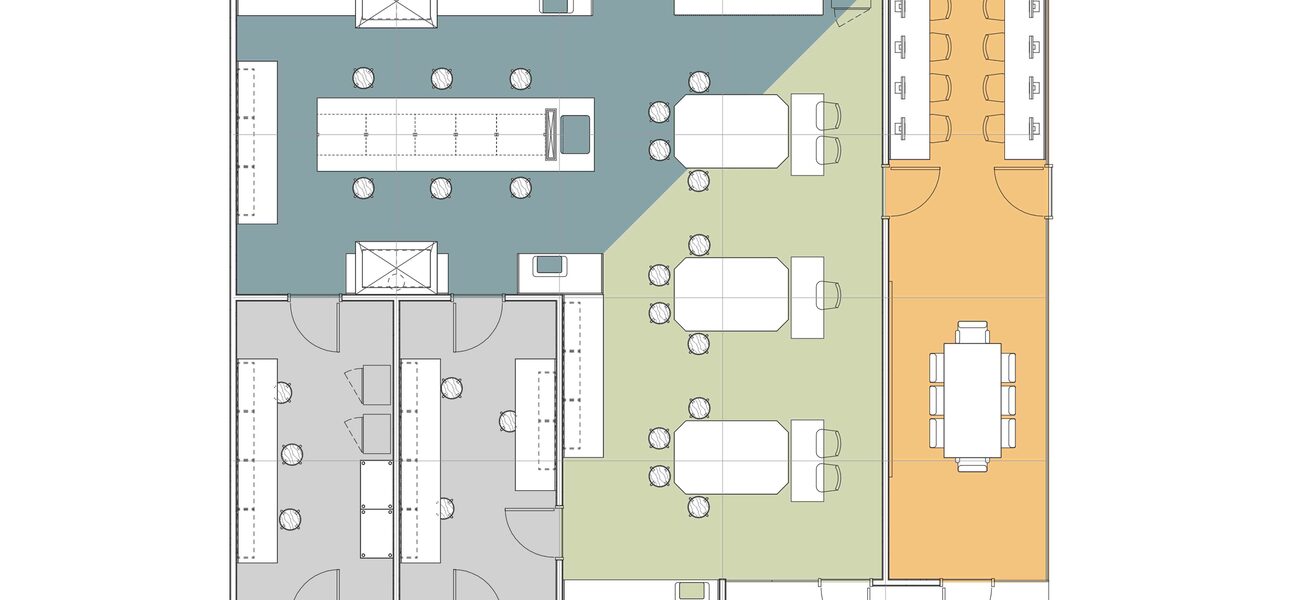Responding to the call to reinvent university science instruction, Virginia Tech’s new classroom building is poised to create “a bona fide learning revolution.” Slated for completion in 2016, the 73,400-sf facility will offer flexible, innovative teaching spaces that are “radically different” from anything previously seen on the Blacksburg campus, according to Jill Sible, assistant provost for undergraduate education at the largest producer of STEM (science, technology, engineering, math) degrees in the state.
“Our new classroom building will house several immersive environments designed to foster team-based active learning,” explains Sible. “The goal is to engage students, from freshman year on, in an inquiry-based approach.”
Integrated Interdisciplinary Approach
The need to attract more students to careers in the STEM fields has long been identified as a nationwide challenge by the National Academy of Sciences. An additional 1 million science graduates will be required over the next several decades to keep the U.S. competitive in the global market.
To fill this gap, the President’s Council of Advisors on Science and Technology has called for universities to reinvent science pedagogy, particularly for entering students. The emphasis falls on retention: A curriculum that captures students’ interest early is far more likely to propel them into upper division coursework.
Guided by that thinking, Virginia Tech “threw away the cookbook” for traditional science instruction, pioneering a fresh approach to both foundational learning and the physical space in which it occurs. The new program incorporates coursework in multiple disciplines, reflecting the reality of today’s science and technology careers.
“The exciting questions in science are really interdisciplinary, requiring teams from multiple backgrounds,” says Sible. “There is an emerging recognition that even undergraduates must prepare to work in interdisciplinary fields.”
For their first two years, entering students in the College of Science’s new Integrated Science Curriculum take an eight-credit combined lecture and lab. They study the equivalent of freshman biology, chemistry, calculus, calculus-based physics, statistics, and computer science, all in “one very integrative and problem-based learning experience.”
Program enrollment has grown from the initial pilot of 12 students to 50 today. Concurrently, the Commonwealth of Virginia approved four new undergraduate degrees that build on the two-year foundation: in neuroscience, nanoscience, systems biology, and computational modeling and data analytics.
“These last three are really pretty novel in the undergraduate realm,” Sible points out.
The Setting
In Virginia Tech’s upcoming building, which was designed by EYP Architecture & Engineering of Boston, two new types of spaces will serve as the setting for a host of undergraduate programs including Integrated Sciences courses: the SCALE-UP (Student Centered Active Learning Environments for Undergraduate Programs) classroom and the classatory, a hybrid classroom/lab.
What’s novel about the two SCALE-UP rooms is the way they are furnished: each has a total of 11 7-foot round tables that seat nine students, typically organized in three teams of three. The table diameter was no casual choice, explains Sible. Rather, it’s the result of research conducted by Robert Beichner, director of North Carolina State University’s STEM Education Initiative, who found that size optimal for the desired sense of community and interaction.
The round tables allow students to face one another for group work. Instead of a single line of sight to a lecturer, large monitors and displays are mounted all around the room to make shared material visible. White boards invite students to get up and contribute to their learning.
“Environment is so critical to behavior,” explains Sible. “The layout reminds students that we’re on the cutting edge. They get to talk, socialize, and relax a bit more. Essentially, we are giving them permission to have fun.”
The distinctive configuration is emblematic of the new approach to learning.
“SCALE-UP is really a pedagogy more than a space,” she continues. “Students spend the majority of their time collaborating on real-world problems and case studies. When I teach my sophomore-level cell and molecular biology class in SCALE-UP, I lecture for maybe 15 to 30 minutes a week maximum.”
The new SCALE-UP rooms benefit from Virginia Tech’s experience test-driving the concept in two other campus buildings. While the first rooms were wildly popular, with a waiting list for scheduling, the technology use among students was underestimated.
The early iterations provided one laptop for every team of three students, following the SCALE-UP notion that each team collaborates on a dedicated computer. However, Sible found that students will bring their own laptops “no matter what.” In fact, they typically use two or more devices at the same time, creating a high demand for wireless capacity.
The tables are all equipped with connections for microphones, power cords, and cables to wall-mounted monitors. This fixed technology means that they must remain in place. Nevertheless, they have proven successful in fostering team-based active learning in a wide variety of courses—physics, psychology, non-major geoscience classes, and all the Integrated Science classes, says Sible.
Classatory
The second new type of space in the building is the classatory, which Sible describes as “probably the most challenging, the most exciting, and the most expensive part of this entire project.” As the name suggests, the classatory houses a blend of classroom and lab functions, supporting the gamut of coursework—biology, chemistry, physics—Integrated Science Curriculum participants might study within the same class period.
Highly flexible, each of the new building’s four classatories offers a central area for wet lab experimentation. Moveable rectangular tables can extend the lab benches, or they can be arranged to form a central teaching space suitable for whole-class instruction, demonstrations, or shared instrumentation. The furniture is easy to reconfigure, so the changes can be made even between class periods.
In an example of a “service-light” approach, each classatory has just one or two fume hoods and sinks in an alcove off to the back.
“Surprisingly, our chemistry faculty was on board with just a few hoods,” notes Sible. “These rooms are not designed to be pure chemistry or biology labs. We have other facilities on campus where the fume hood population is more intense, so we don’t need to duplicate those resources.”
A row of enclosed but interconnected prep labs alternates with the fume hood alcoves along the back of the adjoining classatories. These areas accommodate equipment requiring supervision from the preparatory staff and other types of work that happen in shared spaces.
A highlight of the classatory scheme is the smaller room between two wet labs that provides a dedicated space for computation and write-up, avoiding the perilous mix of laptops and chemicals. Here students can plan and design experiments together, and then compile their results into joint presentations for a public audience.
“This allows us to really teach science the way we practice science, in a more authentic way, from beginning to end,” comments Sible.
The computation room also has another benefit, doing dual duty as informal, after-hours study space. The classatory wet labs can be closed off at night while the write-up space remains accessible.
“This arrangement offers great space efficiency,” she says. “Each area of 36 students occupies a total of just 57 sf per student.”
In addition to representing a real cultural shift at Virginia Tech, the classatories embody the university’s commitment to curb the loss of STEM majors, particularly among women and under-represented populations.
“The enrollment numbers are not going to go up if you stick students in boring labs in the worst spaces as freshmen,” says Sible. “This building speaks to our intent to give first- and second-year students a desirable learning experience and get them off to the right start.”
Other Spaces
Other classrooms in the new building attain flexibility and promote collaboration through reconfigurable furniture that makes it easy to change table shapes and seating groups. Monitors and whiteboards all around the room permit students to work and move around in real time. Moveable walls allow several larger rooms to be divided in half, going from a capacity of 150 students down to 75 or from 80 to 40.
One of the classrooms is even more flexible, serving as a black-box space to accommodate a variety of arts instruction, in the expansion of STEM to STEAM. Sible suggests the room might make the perfect home for a music professor teaching a class in digital sound manipulation, for example, or offer studio or performance space—“anything that might turn the classroom into a different type of engaged learning space.”
Even though the innovative classrooms are capable of supporting traditional lecturing and teaching, EYP lead designer and principal Kip Ellis is dubious that will happen. He repeats a reply to that question delivered at the project kick-off meeting: “For those faculty who want to do a traditional lecture-based class, we have an entire campus filled with rooms to suit them, not this building!”
As another indication of its key role in transforming science pedagogy, the new classroom building has been designed for transient occupancy, with no faculty offices. Instead, learning spills out of the classrooms into an inviting array of informal spaces, for instance, gathering areas where professors can hold office hours on the fly, or corridor walls that display student projects and artifacts of learning.
“EYP has done a lot of research and has documented the need for a variety of different types of spaces for individuals to work in—social settings, more semi-private settings, and group settings. There is a little bit of everything throughout this building,” says Sible.
T-search for Advanced Courses
While the classatory adds hands-on discovery and discussion capabilities to introductory science classes, more extensive lab capabilities are required at the upper-division level. With today’s emphasis on undergraduate research, especially mentored research that might be part of a capstone project in certain majors, EYP has documented an increasing need for a research-like environment in advanced courses.
Yet it can be challenging for smaller institutions with limited resources and a lack of subsidized faculty research labs to provide these environments. Ellis notes that this can be an obstacle for a curriculum that aims to incorporate the use of research methodology as an integral part of advanced coursework.
In response, EYP has designed another new classroom concept, the T-search, a hybrid model of research and teaching lab that combines dedicated space for wet science activity with areas for instruction/discussion, informal write-up, and support or prep rooms, all in a large suite-type arrangement.
One of the main advantages of the T-search is its flexibility, says Ellis. Faculty have space for research equipment and can work on their own projects during the academic year. The amount of research space in the room can be increased by reconfiguring the instruction/discussion area, making it especially appropriate for students working on capstone projects during the summer. Instruments and equipment are thus in close proximity, removing the inconvenient divide between research lab and teaching lab. Similarly, the discussion area can be expanded to accommodate write-up functions.
A T-search model is currently in design development for an EYP project at Concordia College in Minnesota. “This is one of the first prototypes of a fully integrated environment for STEM instruction,” says Ellis. “It is prompting a great discourse on what the future of these types of spaces will be.”
By Nicole Stahl
This report is based on a presentation at the Tradeline College and University Science Facilities 2014 conference.



